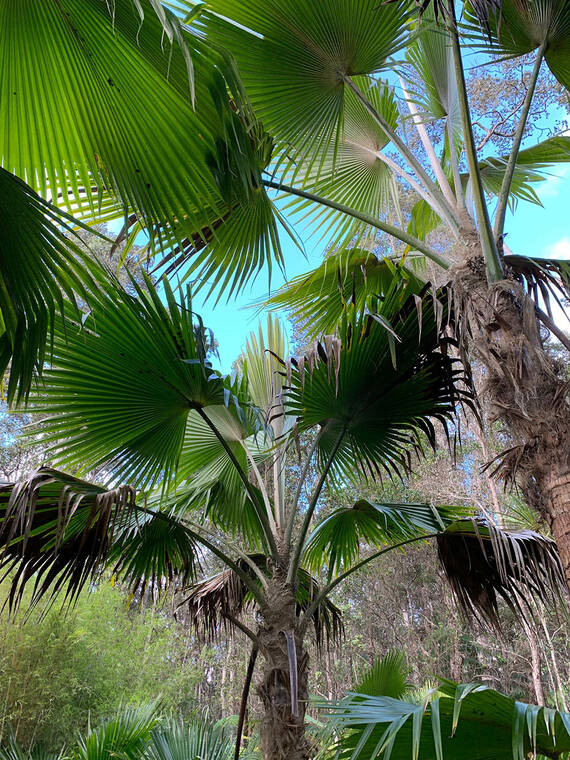Hawaii is famous throughout the world for its beauty, friendly people and for the varied climate that is ideal for almost all the palms on the planet. This Oct. 10-19, the International Palm Society is celebrating its 32nd biennial meeting here. Every two years, members from all over the world meet to learn about this amazing family of plants. They meet in such exotic places as Thailand, Brazil, Madagascar and New Caledonia. This year they will focus on the rare endemic genus Pritchardia. To get involved in this year’s events, go to the IPS website, palms.org for details.
When the first Polynesians arrived in the Hawaiian Islands, there were no coconut palms here. There were no kukui, mountain apple, breadfruit, kalo and many other plants we think of as Hawaiian. However there were vast forests of fan palms unique to our islands. These were of the genus Pritchardia.
If you are truly interested in conservation, then choose to protect one of our most unique plant species, the genus Pritchardia. If you think that coconut palms, kukui, bananas, and ti are natives and seem to grow easily, then it is time to rethink! These plants are alien, non-native species brought to Hawaii by the Polynesians as they migrated across southeast Asia and the Pacific Ocean. These are referred to as canoe plants.
For example, our state tree, the kukui, originated in what is now Indonesia, it is believed. Our state tree probably should be the Loulu Palm genus because it is endemic. That is, it found only in Hawaii. Of course there are exceptions to this. Four species are found in the South Pacific. Two species were only recently discovered. The Hawaiian loulu actually evolved here and are found growing naturally only in Hawaii. At one time, there may have been many dozens of species, but with the introduction of the Polynesian rat and pig, many must have perished. Later introduction of grazing animals did further damage so that now there are only remnants of what must have been vast populations of the loulu.
The native Loulu group or Pritchardia Palms are truly a vanishing species in Hawaii. Of some 28 species of Pritchardias in the world, 24 are natives to Hawaii. The others are found in Fiji and the Tuamoto Islands.
It is a shame that many of these species have declined in number to the point that they are almost extinct. It s suspected that there may have been other species present on other Pacific islands, but have probably disappeared as humans with pigs and rats migrated though out the tropical Pacific thousands of years ago.
For example, one specie found along the coast of Ka‘u and Kona was almost extinct, In 1970, seeds of this palm were collected at the Beamer home adjacent to Punalu‘u Black Sand Beach. The seeds were planted in flats and grown to landscape size. Today, several groves are beautifying the Punaluu area of Ka‘u. Trees from this batch of seed also found their way to the King Kamehameha Hotel, Kona Outdoor Circle garden and many other sites around the island. Seeds distributed by the Hawaii Island Palm Society to California and even southern France and Morocco have been found to do well in protected locations.
Pritchardia affinis/maideniana is rarely found in the wild and only occasionally in the landscape. The most common types are the two introduced species from the south Pacific. These are Pritchardia thurstonii and Pritchardia pacifica. “Thurston’s Loulu” is noted for flower clusters up to six feet long. Pritchardia pacifica has very large leaves that were used in the old days as sunshades and umbrellas. These species are adapted to dry coastal locations. The Kona Loulu prefers sunny dryer locations but has been grown at elevations as high as 3,000 feet. The other rare one is named after George Schattauer, Kona kamaaina. A few trees are found above Kaohe, Honomalino and Hookena. This specie and Pritchardia beccariana from Kulani Prison Road near Volcano are being distributed on the Big Island. The latter is a spectacular rainforest palm with leaves almost six feet across. It prefers moist locations with wind protection. Many species have been tested at Kona Cloud Forest Sanctuary in Kaloko Mauka, North Kona and at Amy Greenwell Ethnobotanical Garden in South Kona.
It’s important to the survival of many of these beautiful species to use them in our gardens. Unfortunately, most nurseries do not carry the native Loulus, and seed of some species are difficult to obtain.
The International Palm Society promotes the protection, propagation and use of palms throughout the world. To contact them go to hawaiiislandpalmsociety@gmail.com for detailed information.


